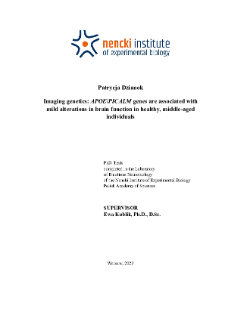- Search in all Repository
- Literature and maps
- Archeology
- Mills database
- Natural sciences
Advanced search
Advanced search
Advanced search
Advanced search
Advanced search

Object
Title: Imaging genetics: APOE/PICALM genes are associated with mild alterations in brain function in healthy, middle-aged individuals : PhD thesis
Institutional creator:
Instytut Biologii Doświadczalnej im. Marcelego Nenckiego PAN
Contributor:
Kublik, Ewa (1968– ) : Supervisor
Publisher:
Nencki Institute of Experimental Biology PAS
Place of publishing:
Description:
131 pages : illustrations ; 30 cm ; Summary of professional accomplishments: access to original works available only in the thesis' manuscript stored at the library collection ; Bibliography ; Summary in Polish
Degree name:
Degree discipline :
Degree grantor:
Nencki Institute of Experimental Biology PAS ; degree obtained: 28.06.2024
Type of object:
Abstract:
The process of aging is a complex biological phenomenon that results in a decline in cellular function and tissue degeneration. Late-onset Alzheimer's disease (LOAD), the most prevalent cause of dementia, is a neurodegenerative disease that is often diagnosed in advanced stages. The etiology of LOAD is multifaceted and includes lifestyle, environmental, and genetic factors. Detecting neurodegenerative diseases early is crucial for global healthcare and for affected individuals, as it enables the potential for early prevention and treatment. Therefore, understanding how Alzheimer's disease risk genes impact the brain function of healthy individuals is crucial in advancing this process. This dissertation describes a study on the relationship of LOAD risk genes and brain function/structure and basic health indicators in middle-aged individuals without symptoms of dementia. A genetic screening involving 200 participants was conducted to assess two LOAD risk genes: APOE (encoding apolipoprotein E) and PICALM (encoding phosphatidylinositol binding clathrin assembly protein). A comprehensive demographic data was collected, along with a battery of psychometric tests. Based on the screening results, distinct groups were defined including individuals with no risk (N), carriers of risk variant exclusively in the APOE gene (A+P-), and carriers of risk variants in both the APOE and PICALM genes (A+P+). The groups differences were studied with neuroimaging techniques, involving both structural methods (magnetic resonance imaging, MRI) and functional approaches (electroencephalography, EEG; and functional MRI, fMRI). Extended blood tests were also performed, including microRNA panel associated with Alzheimer's disease. The groups were similar in demographic characteristics, and most psychometric tests yielded comparable results. Importantly, no differences between control and risk groups were found in memory abilities as assessed by The California Verbal Learning Test (CVLT). In terms of health indicators, the at-risk groups differed from control group in standard blood test parameters, showing slightly elevated levels of eosinophils and hemoglobin content in red blood cells. Analysis of circulating miRNAs in plasma revealed downregulation of miR-29b- 3p, a trait reported in scientific literature as characteristic of Alzheimer's disease (AD) patients. The findings indicated a reduction in the complexity of the EEG signal and a phenomenon termed “slowing” of the EEG. Analysis of brain responses during MSIT showed differences between the study groups in the components related to the attention and cognitive control (N2 event-related potential component) and during response execution phase (late sustained potential, LSP). In terms of brain structure, a reduced thickness of the cerebral cortex is one of the symptoms of Alzheimer's disease; our study showed similar changes in the right temporal pole for individuals with risky gene variants. fMRI connectivity showed significant alterations in small clusters within some areas (e.g., posterior cingulate cortex) linked to the default mode network (DMN). Furthermore, task-related fMRI revealed differences in brain activation between the groups in areas partially associated with this network. Disruption of the DMN is frequently observed in the neurodegenerative diseases. Moreover, alterations in regions linked to the so-called signature of Alzheimer's Disease, such as the angular gyrus, inferior temporal gyrus, and supramarginal gyrus, were also found. An important finding is the absence of a linear accumulation of effects along the risk level axis. APOE and PICALM seem to influence the organism in a complex way. Longitudinal studies are essential to identify individuals from our experimental groups, who will eventually develop symptoms of the disease.
Detailed Resource Type:
Resource Identifier:
Source:
Language:
Language of abstract:
Rights:
Terms of use:
Copyright-protected material. May be used within the limits of statutory user freedoms
Copyright holder:
Publication made available with the written permission of the author
Digitizing institution:
Nencki Institute of Experimental Biology of the Polish Academy of Sciences
Original in:
Library of the Nencki Institute of Experimental Biology PAS
Access:
Object collections:
- Digital Repository of Scientific Institutes > Partners' collections > Nencki Institute of Experimental Biology PAS
- Digital Repository of Scientific Institutes > Partners' collections > Nencki Institute of Experimental Biology PAS > Dissertations
- Digital Repository of Scientific Institutes > Partners' collections > Nencki Institute of Experimental Biology PAS > Dissertations > PhD Thesis
- Digital Repository of Scientific Institutes > Literature
- Digital Repository of Scientific Institutes > Literature > Thesis
Last modified:
Dec 16, 2024
In our library since:
May 17, 2024
Number of object content downloads / hits:
77
All available object's versions:
https://rcin.org.pl./publication/277579
Show description in RDF format:
Show description in RDFa format:
Show description in OAI-PMH format:
Objects Similar
Więckowska-Gacek, Angelika
Pluta, Ryszard Kida, Elżbieta Lossinsky, AS. Wiśniewski, HM. Mossakowski, Mirosław Jan (1929–2001)
Barcikowska, Maria
Tripplin, Teodor (1813–1881)
Gliwa, Renata

 INSTYTUT ARCHEOLOGII I ETNOLOGII POLSKIEJ AKADEMII NAUK
INSTYTUT ARCHEOLOGII I ETNOLOGII POLSKIEJ AKADEMII NAUK
 INSTYTUT BADAŃ LITERACKICH POLSKIEJ AKADEMII NAUK
INSTYTUT BADAŃ LITERACKICH POLSKIEJ AKADEMII NAUK
 INSTYTUT BADAWCZY LEŚNICTWA
INSTYTUT BADAWCZY LEŚNICTWA
 INSTYTUT BIOLOGII DOŚWIADCZALNEJ IM. MARCELEGO NENCKIEGO POLSKIEJ AKADEMII NAUK
INSTYTUT BIOLOGII DOŚWIADCZALNEJ IM. MARCELEGO NENCKIEGO POLSKIEJ AKADEMII NAUK
 INSTYTUT BIOLOGII SSAKÓW POLSKIEJ AKADEMII NAUK
INSTYTUT BIOLOGII SSAKÓW POLSKIEJ AKADEMII NAUK
 INSTYTUT CHEMII FIZYCZNEJ PAN
INSTYTUT CHEMII FIZYCZNEJ PAN
 INSTYTUT CHEMII ORGANICZNEJ PAN
INSTYTUT CHEMII ORGANICZNEJ PAN
 INSTYTUT FILOZOFII I SOCJOLOGII PAN
INSTYTUT FILOZOFII I SOCJOLOGII PAN
 INSTYTUT GEOGRAFII I PRZESTRZENNEGO ZAGOSPODAROWANIA PAN
INSTYTUT GEOGRAFII I PRZESTRZENNEGO ZAGOSPODAROWANIA PAN
 INSTYTUT HISTORII im. TADEUSZA MANTEUFFLA POLSKIEJ AKADEMII NAUK
INSTYTUT HISTORII im. TADEUSZA MANTEUFFLA POLSKIEJ AKADEMII NAUK
 INSTYTUT JĘZYKA POLSKIEGO POLSKIEJ AKADEMII NAUK
INSTYTUT JĘZYKA POLSKIEGO POLSKIEJ AKADEMII NAUK
 INSTYTUT MATEMATYCZNY PAN
INSTYTUT MATEMATYCZNY PAN
 INSTYTUT MEDYCYNY DOŚWIADCZALNEJ I KLINICZNEJ IM.MIROSŁAWA MOSSAKOWSKIEGO POLSKIEJ AKADEMII NAUK
INSTYTUT MEDYCYNY DOŚWIADCZALNEJ I KLINICZNEJ IM.MIROSŁAWA MOSSAKOWSKIEGO POLSKIEJ AKADEMII NAUK
 INSTYTUT PODSTAWOWYCH PROBLEMÓW TECHNIKI PAN
INSTYTUT PODSTAWOWYCH PROBLEMÓW TECHNIKI PAN
 INSTYTUT SLAWISTYKI PAN
INSTYTUT SLAWISTYKI PAN
 SIEĆ BADAWCZA ŁUKASIEWICZ - INSTYTUT TECHNOLOGII MATERIAŁÓW ELEKTRONICZNYCH
SIEĆ BADAWCZA ŁUKASIEWICZ - INSTYTUT TECHNOLOGII MATERIAŁÓW ELEKTRONICZNYCH
 MUZEUM I INSTYTUT ZOOLOGII POLSKIEJ AKADEMII NAUK
MUZEUM I INSTYTUT ZOOLOGII POLSKIEJ AKADEMII NAUK
 INSTYTUT BADAŃ SYSTEMOWYCH PAN
INSTYTUT BADAŃ SYSTEMOWYCH PAN
 INSTYTUT BOTANIKI IM. WŁADYSŁAWA SZAFERA POLSKIEJ AKADEMII NAUK
INSTYTUT BOTANIKI IM. WŁADYSŁAWA SZAFERA POLSKIEJ AKADEMII NAUK




































